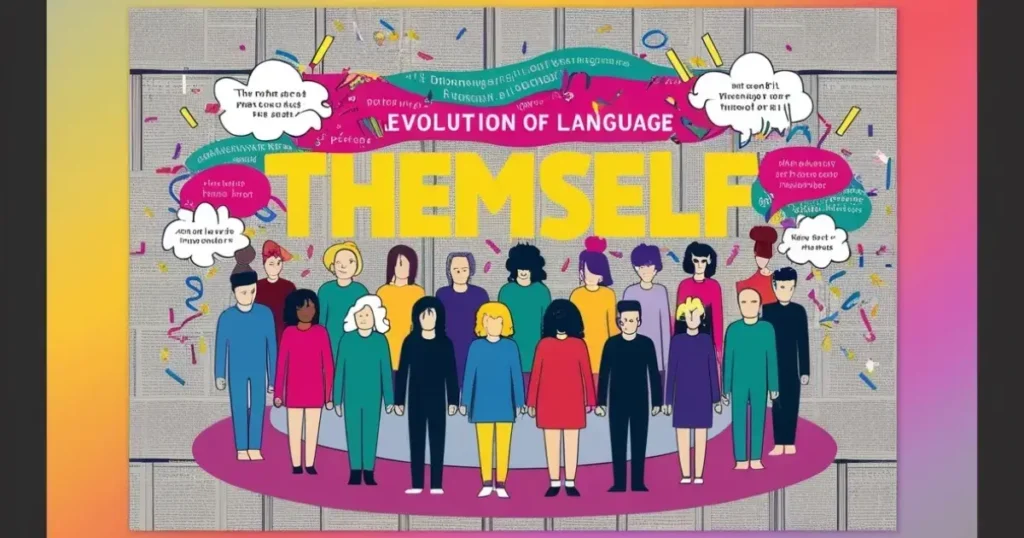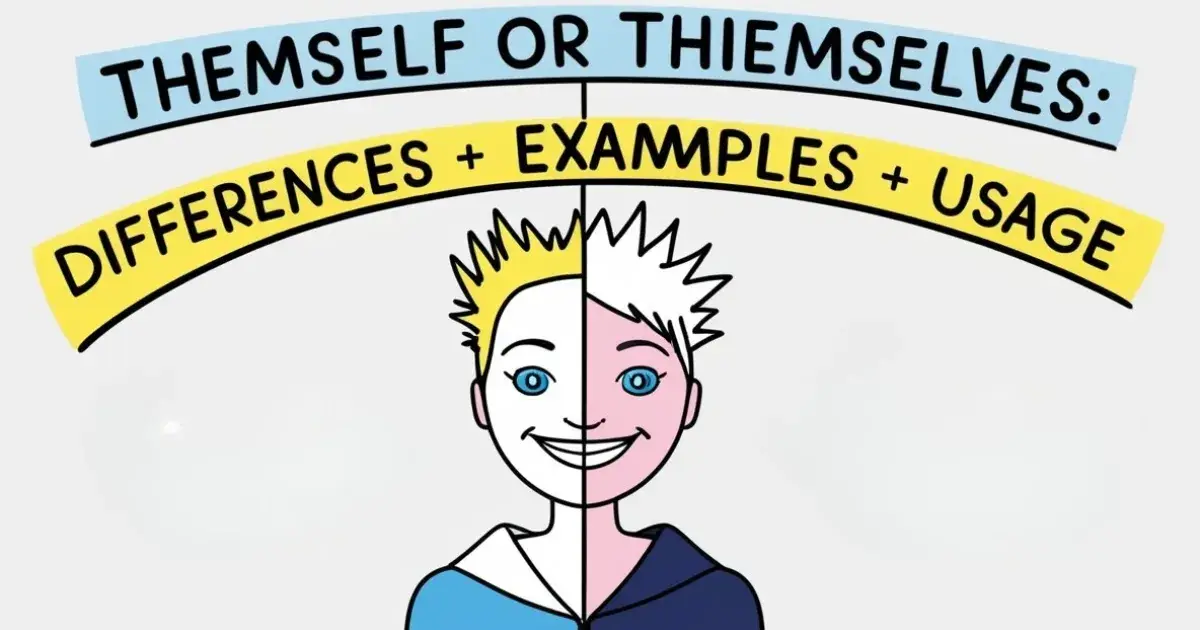Language is constantly evolving, and one area that has seen significant change in recent years is the use of pronouns, particularly when it comes to gender-neutral language. Two terms that often cause confusion are “themself” and “themselves.” Both of these words are used as reflexive pronouns, but they are not always interchangeable. In this article, we will dive deep into the differences between “themself or themselves,” explore when to use each one, and provide helpful examples to clarify their proper usage.
Why Are “Themself” and “Themselves” Confused?
The confusion between “themself” or themselves often stems from their similarity in function. Both are reflexive pronouns, which means they refer back to the subject of the sentence. The real challenge, however, lies in understanding when to use “themself” and when “themselves” is appropriate.
While “themselves” has long been accepted in standard English as the reflexive form of “they,” “themself” has emerged as a grammatically correct alternative, particularly in the context of non-binary and gender-neutral language. This has led to debate, with some still arguing against “themself” and others advocating for its widespread use.
In this article, we will break down the differences, explore real-life examples, and answer some frequently asked questions about “themself or themselves.”
The Use of “Themself” in Modern English

To fully understand the difference between “themself or themselves,” we need to define each term and explore how they are used grammatically.
What Does “Themself” Mean?
“Themself” is a singular reflexive pronoun used to refer to a person, especially when that person is non-binary or prefers gender-neutral language. It is the singular equivalent of “themselves,” which is traditionally used for plural subjects.
Example sentences:
- “Alex decided to go on the trip by themself.”
- “The artist lost themself in their work.”
Contexts in Which “Themself” is Correct
“Themself” is a relatively recent addition to the English language, and it’s primarily used in singular contexts, particularly for non-binary individuals who prefer they/them pronouns. Traditionally, “themself” was often considered grammatically incorrect, with “themselves” being the standard reflexive pronoun. However, as language has evolved to better reflect the diversity of human experience, “themself” has emerged as a grammatically acceptable choice for those who prefer non-binary pronouns.
Primarily for Singular Non-Binary Individuals
The main context in which “themself” is used is when referring to a singular individual who prefers they/them pronouns. Non-binary individuals, those who don’t identify strictly as male or female, often prefer “they” as a pronoun, and this also extends to the reflexive form—“themself”.
For example:
- “Jordan took care of themself after a long day.”
- “Sam has learned to be independent and do things for themself.”
In these sentences, the use of “themself” refers to an individual (non-binary in these examples) who is the subject of the sentence. The “themself” reflects back to the singular subject, just like a traditional reflexive pronoun.
Example with a Non-Binary Individual:
- “Alex felt proud of completing the project themself.”
Here, “themself” is the correct form because Alex is a singular subject who prefers they/them pronouns. “Themself” aligns with their gender identity, making it the appropriate reflexive form.
Why “Themself” is Gaining Popularity
The rise in the use of “themself” reflects broader shifts in language that are happening alongside societal changes regarding gender identity. Over the years, more and more people, including non-binary and genderqueer individuals, have embraced they/them pronouns as a way of more accurately reflecting their gender identity. This acceptance has spurred language evolution, leading to the introduction and growing acceptance of “themself” as a legitimate form.
How Societal Changes Around Gender Identity Influence Language Evolution
Language and culture are deeply intertwined. As society becomes more aware of and respectful toward non-binary and gender-diverse identities, language evolves to reflect these changes. The use of “they” as a singular pronoun is a prime example of how grammar adapts to meet the needs of a more inclusive world.
Historically, “they” was used exclusively in the plural sense, but it has increasingly been used for singular subjects, particularly for those who identify outside of the traditional male or female gender binary. With this, the reflexive form also needed to adapt. While “themselves” is still the dominant reflexive pronoun for plural subjects, “themself” was introduced to align with the singular “they”.
For example:
- “They taught themself to cook.”
In this sentence, “they” is used as a singular pronoun, and “themself” follows suit as the corresponding reflexive pronoun. This language shift allows for the inclusion of individuals who prefer non-binary pronouns, enabling a more accurate reflection of their identity.
Distinction from Traditional Grammatical Norms
Before the rise of gender-neutral pronouns, English had more rigid gendered rules. Words like “he” and “she” dominated the language, with “himself” and “herself” as the corresponding reflexive forms. These norms were built around the idea of a strict male-female binary, leaving little room for non-binary individuals to feel represented in language.
The introduction of “themself” challenges these traditional grammatical structures. It serves as a tool for inclusivity, making the language more adaptable and accepting of gender diversity.
Some people may still find the use of “themself” jarring or grammatically incorrect, as it goes against centuries of grammatical tradition. However, as the understanding of gender expands, “themself” is gaining recognition in modern grammar guides and among language scholars, making it an increasingly accepted form.
Example of Societal Influence on Language:
- “They took care of themself after a long week.”
In this example, the subject “they” is singular and non-binary, and the reflexive form “themself” aligns with this usage. The phrase reflects not only the correct grammar but also acknowledges the evolving understanding of gender identity in society.
The Role of “Themselves” in Standard English Usage

What Does “Themselves” Mean?
“Themselves” is the plural reflexive pronoun that is used to refer to multiple people or things. It can also be used to refer back to a singular subject when the subject is represented by “they” (e.g., a non-binary person).
Example sentences:
- “The students prepared themselves for the final exams.”
- “They did it themselves.”
Contexts and Examples of “Themselves”
“Themselves” is a versatile pronoun that can be used in different contexts, depending on the grammatical role it plays in a sentence. It is commonly used as a reflexive pronoun, emphatic pronoun, and in plural constructions. Understanding these various contexts is essential for using “themselves” correctly.
1. Reflexive Pronouns:
As a reflexive pronoun, “themselves” refers back to the subject of the sentence, indicating that the subject is both performing and receiving the action. It is used for plural subjects or singular “they” (in non-binary contexts).
- Example:
- “The team congratulated themselves on the successful project.”
In this sentence, “themselves” is used reflexively, meaning the team did something for their own benefit (they congratulated themselves). The action returns to the subject (the team), which is plural.
- Example:
- “The employees took pride in completing the task themselves.”
Here, “themselves” refers back to the plural subject, “the employees”, indicating that the employees performed the task independently, without help.
2. Emphatic Pronouns:
In this context, “themselves” serves to emphasize the subject of the sentence. It is often used when someone wants to emphasize that the subject did something on their own, or as a way of adding emphasis to the action.
- Example:
- “They did it themselves.”
This sentence emphasizes that “they” (the subject) performed the action alone, without anyone else’s assistance. It is a way of stressing their independence or effort.
- Example:
- “She completed the marathon herself.”
In this case, “herself” serves the same function as “themselves” would, emphasizing that the subject (in this case, “she”) did the action on her own.
3. Plural Construction:
“Themselves” is also used when the subject is plural. It reflects the plural nature of the subject and indicates that the action applies to all the members of the group.
- Example:
- “The students worked on their assignments by themselves.”
In this sentence, “by themselves” emphasizes that the students did the work independently, without external help. The plural subject “the students” is reflected by the plural pronoun “themselves.”
- Example:
- “The children played in the park by themselves.”
Here, “themselves” is used to show that the children (plural subject) did the action independently, reinforcing that they did it without assistance.
Synonyms for “Themself” and “Themselves”
To enhance your understanding, here are some common synonyms for both words, helping to illustrate the context in which each is used.
Synonyms for “Themself”:
- Himself
- Herself
- Yourself
- Itself
- Oneself
- One’s own
- Independently
- Alone
- Singly
- By one’s self
Synonyms for “Themselves”:
- Themselves (plural)
- Themselves (used with singular ‘they’)
- Himself (plural)
- Herself (plural)
- You all (plural)
- Each other (when reciprocal)
- By themselves (plural)
- On their own (plural)
- Independently (plural)
- As a group (plural)
Comparison Table: “Themself” vs. “Themselves”
Here’s a quick reference table to help compare “themself or themselves” across different aspects of grammar and usage.
| Aspect | Themself | Themselves |
|---|---|---|
| Pronoun Type | Singular Reflexive Pronoun | Plural Reflexive Pronoun or Singular (non-binary) |
| Gender Usage | Used for singular, typically gender-neutral | Used for plural subjects or singular (non-binary) |
| Formal Usage | Less common in formal writing, but increasingly accepted | Common in both formal and informal settings |
| Grammar | Singular subject (“They went by themself”) | Plural subject (“They went by themselves”) |
| Common Context | Non-binary individuals or general singular usage | Plural groups or non-binary singular usage |
When to Use “Themself” and “Themselves”

Now that we have a clearer understanding of the definitions, let’s break down when to use “themself or themselves.” This section will guide you through specific contexts for each term.
When to Use “Themself”
Use “themself” when referring to a singular person who prefers a non-binary pronoun, or in general for gender-neutral references. While “themself” is less common in traditional grammar, it is gaining traction as society becomes more inclusive of gender diversity.
Examples:
- “Jordan decided to go to the store themself.”
- “Each person needs to take care of themself.”
When to Use “Themselves”
“Themselves” is used in two main situations:
- When referring to plural subjects.
- When singular “they” is used for non-binary individuals, but in certain formal contexts, “themselves” may be preferred over “themself.”
Examples:
- “They bought themselves a new car.”
- “The employees took pride in completing the project themselves.”
Everyday Usage Examples
To ensure you fully grasp the distinction, let’s explore more everyday scenarios in which “themself” and “themselves” are used.
Themself:
- “Alex went on vacation by themself.”
Examples with “Themselves”:
- “The team congratulated themselves after the win.”
- “The children enjoyed playing by themselves in the park.”
Plural vs. Singular: When to Use Each
Understanding when to use “themself” versus “themselves” can be tricky, especially when dealing with plural and singular contexts. Here’s a breakdown to help clarify their proper use.
Plural Contexts: Always “Themselves”
When you’re referring to a plural subject, “themselves” is always the correct form. It indicates that the group (the subject) performed an action on themselves, or that the action applies to them as a whole.
- Examples:
- “The children washed themselves.”
- “The employees handled it themselves.”
In these examples, “themselves” correctly refers back to the plural subject (children, employees).
Singular Contexts: “Themself” vs “Themselves”
In singular contexts, “themself” has become increasingly accepted, particularly in non-binary and gender-neutral language. However, “themselves” is still used in traditional grammar, even for singular subjects, especially in informal speech.
- Traditional Usage (Singular): Traditionally, “themselves” is reserved for plural subjects. However, many English speakers still use it in singular contexts (often for non-binary or gender-neutral individuals), leading to a blending of grammatical rules.
- Modern Usage (Singular): In non-binary contexts, “themself” is more widely accepted. For example, someone who prefers “they/them” pronouns would use “themself” as a reflexive pronoun.
- Sentence Comparison:
- “The person enjoyed themself” (Modern, Non-Binary Usage)
- “The person enjoyed themselves” (Traditional Usage for Singular)
The distinction comes down to the evolution of language and how non-binary individuals prefer to express themselves.
Common Mistakes and Misunderstandings

Themself vs. Themselves in the UK and US
Historically, “themselves” was the only acceptable form, and “themself” was seen as a grammatical error. The use of “themself” has become more accepted in the US, especially in non-binary contexts, but in the UK, the traditional rules of grammar still hold strong, and “themself” is less commonly used.
- Example Sentences:
- US: “Alex made sure to prepare themself for the presentation.”
- UK: “Alex made sure to prepare themselves for the presentation.”
In the UK, using “themself” in these cases might still sound strange to some, while in the US, it’s gaining ground as a legitimate option.
Common Confusion in Everyday Speech
Many people still confuse “themself” and “themselves” in everyday speech, often defaulting to “themselves” even in singular, non-binary contexts. This confusion usually arises from a lack of awareness about the evolving rules surrounding non-binary language.
- Incorrect Usage Example:
- “The person did it themselves.”
- Correct Usage: “The person did it themself.”
Examples of Correct Usage
“Themself” Examples:
- “Each traveler had to find themself.”
These sentences show “themself” correctly used for singular, non-binary subjects.
“Themselves” Examples:
- “They managed to solve the problem themselves.”
- “The employees organized the event themselves.”
In these examples, “themselves” is correctly used for plural subjects.
Understanding How Both Forms Function in Sentences
- Subject-Verb Agreement: The subject determines the form you use. A plural subject takes “themselves”, while a singular, non-binary subject takes “themself”.
- Choosing One Over the Other: When writing or speaking, think about whether you’re referring to an individual or a group. If it’s an individual who prefers “they/them” pronouns, use “themself”. For a group, always use “themselves.”
Additional Questions and Clarifications
Can “Themselves” Be Used for One Person?
Traditionally, “themselves” is used for plural subjects. However, in modern, non-binary language, it’s not uncommon to see “themselves” used in singular contexts, particularly in informal speech. “Themself” remains the grammatically correct singular reflexive for non-binary individuals.
What is the Correct Grammar: “Theirself” or “Themselves”?
“Theirself” is often considered incorrect in standard English. The correct reflexive form is “themselves”, even when referring to singular, non-binary individuals in modern usage. “Themselves” is the universally accepted form for plural subjects.
Can You Use “Themselves” with “Everyone”?
No, “themselves” should not be used with “everyone”, as “everyone” is singular. The correct sentence would be: “Everyone should do it themselves” (incorrect). Instead, it should be: “Everyone should do it himself or herself” in traditional grammar, or better yet, “Everyone should do it themselves” in a more inclusive, modern sense.
Is “Themself” a Real Word?
Yes! “Themself” is now a legitimate word in English, particularly for non-binary individuals. Though it was not traditionally used, its growing acceptance reflects changes in language due to societal shifts in gender identity.
What is the Origin of “Themself”?
“Themself” has emerged in recent years to better accommodate non-binary gender identities. Though it was once considered incorrect, it is now widely recognized as part of evolving language that seeks to be more inclusive of diverse gender identities.
Alternatives to “Themself” and “Themselves”
Other Pronouns in Reflexive Sentences
In certain cases, other reflexive pronouns can be used in place of “themself” or “themselves”, particularly when referring to individuals who use other pronouns like “himself” or “herself”.
- Examples:
- “He did it himself.”
- “She did it herself.”
These alternatives work for individuals whose gender is clearly defined.
What’s the Best Way to Rephrase Sentences to Avoid Confusion?
To maintain clarity when using non-binary language, try rephrasing sentences to avoid confusion. For example, you can use “the individual” or “the person” instead of a reflexive pronoun to reduce ambiguity:
- “The person took care of things on their own.”
This approach keeps the language clear and respectful.
Conclusion: Themself or Themselves — Which is Correct?
Understanding when to use “themself or themselves” comes down to the context in which you’re speaking or writing.
- “Themself” is used for singular non-binary individuals or anyone who prefers “they/them” pronouns.
- “Themselves” is used for plural subjects or in non-binary singular usage in informal contexts.
It’s essential to stay flexible with language, especially as gender identity continues to evolve. Understanding and using “themself or themselves” correctly not only ensures proper grammar but also demonstrates respect for people’s gender identities.
Language is about communication, and with an increasing focus on inclusivity, understanding and respecting the way individuals express themselves through pronouns has never been more important.

This author is a passionate linguist and grammar enthusiast, dedicated to helping individuals master the art of language. With years of experience in teaching and editing, she brings clarity and precision to every sentence. Tina’s mission is to empower writers of all levels to express themselves with confidence and excellence.

